Speech Studying Economics: The Decline in Enrolments and Why it Matters

Jacqui Dwyer[*]
Head of Information Department
Address to the Business Educators Australasia Annual Council Meeting
Sydney –
It is a pleasure to be with you today to discuss the current challenges facing those teaching economics. Appropriately, we meet at the HC Coombs Centre for Financial Studies, a place named after the Reserve Bank's first Governor, Dr HC Coombs.
Coombs was not only a great leader of the nation's central bank. He had an extraordinary public life, influencing many different areas of public policy. His influence extended to education. In fact, he was initially trained as a teacher, and taught primary school students in the Western Australian wheat belt.[1] After studying economics at university, he taught the subject part-time at the University of Sydney in the late 1930s, in the nation's first economics faculty. He also worked with academics on education policy. But, in the sphere of education, he is best known for establishing the Australian National University, a university that pursued teaching and research in some important areas of economics – including on how trade-exposed economies, like Australia, operate.
Coombs saw economics, and the teaching of it, as important to answering a range of questions that influence social wellbeing and prosperity. His observations of the effects of the 1930s depression motivated in him a desire for economics to be taught well and understood.[2] I wonder what he would think of the state of the study of economics today.
Economics in Australian High Schools
I want to share with you some of the research the Bank has done on the current landscape for teaching economics at Australian high schools. We have been compiling enrolments data and conducting liaison with a broad range of educators and educational bodies in each state.
Let's look first at the number of enrolments in Year 12 economics (Graph 1). What we see here is a dramatic decline in enrolments in economics over the past 25 years. In fact, enrolments have declined by almost 70 per cent since 1992. While most of this decline occurred in the early 1990s, there has been a continued downward drift. This national pattern reflects very similar trends across the Australian states.
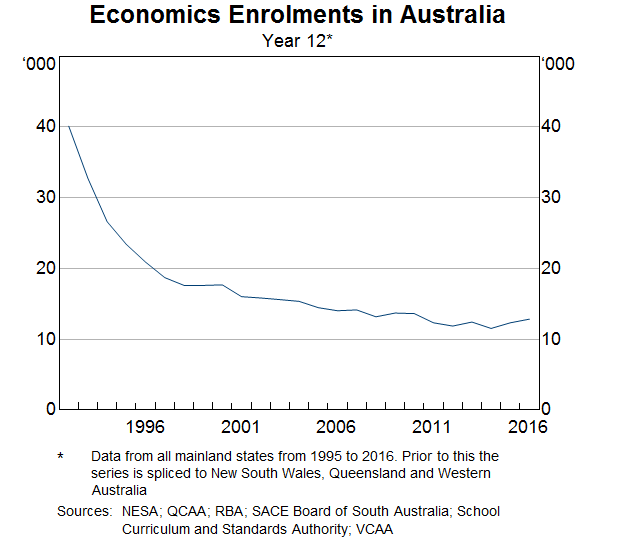
If we distinguish between enrolments of male and female students, we find that female participation in high school economics has declined disproportionately (Graph 2). Females accounted for around one-half of economics students 25 years ago, but little more than one-third of students in 2016.
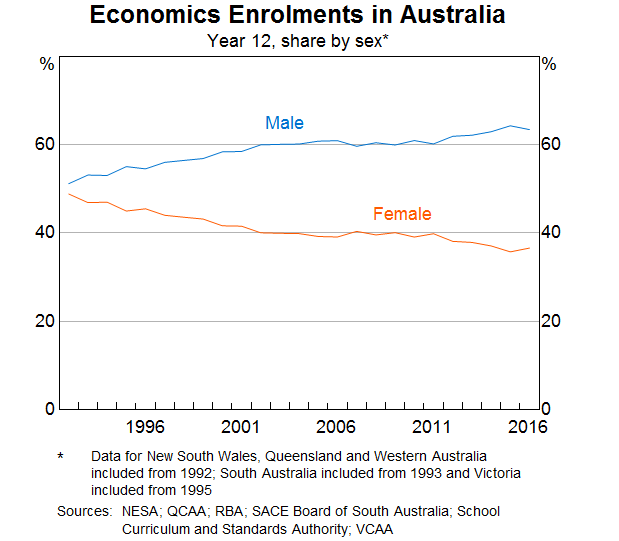
These changes are stark and raise questions about the longer-term health of the student body of economics. To obtain a deeper insight into these changes, we conducted a case study of New South Wales, because we have been able to obtain a rich set of school-level data for this state over a comparable period. [3]
A Closer Look at New South Wales
Looking at New South Wales, we find a similar fall in enrolments in Year 12 economics of nearly 75 per cent since 1991, with the fall concentrated in the early 1990s and then drifting lower in the past two decades (Graph 3). In 2016, fewer than 10 per cent of Year 12 students in New South Wales studied economics. This contrasts with the situation in 1991 when nearly 40 per cent of students studied economics. In fact, at that time, economics was the third most popular subject choice, surpassed only by English and mathematics.
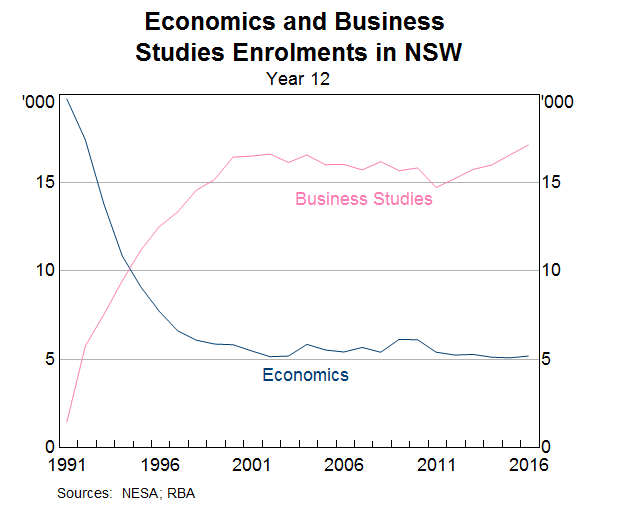
So what changed? The introduction of new subjects in 1991 saw a sharp rise in enrolments in business studies at the expense of economics. The displacement was immediate and pronounced. Business studies expanded steadily throughout the 2000s and, in recent years, there has been renewed interest in it. Business studies is now the fourth most popular subject choice. In contrast, student demand for economics is relatively low, and many schools are considering the feasibility of even offering the subject at all.
Not all of the decline in economics can be attributed to the introduction of business studies. For example, there has not been the same scale of national debate about economic issues as there was in the 1980s and early 1990s, when things like financial deregulation, labour market deregulation and tariff reform were part of national conversations. And when economics was no longer offered as a three unit subject, it became less ‘core’. But our liaison with educators confirms that the single largest factor has been the introduction of business studies. What, then, has influenced the choice made by students between the two subjects?
In essence, economics has an image problem. The Bank's liaison has found that too few students understand what economics is and how it might be relevant to them. Too few educators are equipped to teach it, and a growing share of high school teachers are delivering economics courses without having studied the subject. Too few careers advisors, or educators at large, can articulate how economics is used in the workplace. And too little relevant Australian economic content and teaching resources are available. Consequently, economics is being displaced by business studies - at both high school and university. Business studies is widely perceived as a more employable subject than economics, is less demanding for students to learn and is easier for educators to teach (with fewer concepts to explain and more readily available content).
Economics is not the only analytical subject to have been displaced by new and arguably less demanding subjects. The same challenge has arisen for STEM subjects (science, technology, engineering and mathematics) and we hear much about the decline in enrolments in STEM. So let's compare enrolments in STEM and economics. Total STEM enrolments in New South Wales have declined by 12 per cent over the past 25 years, a much smaller decline than for economics (Graph 4). Furthermore, unlike economics, as a subject group, STEM enrolments have picked up over the past decade, albeit to a lower level than in the early 1990s.
The decline in STEM enrolments has attracted a large amount of media coverage, and a wide range of public policy initiatives have been put in place to address what is seen as a crisis. Private firms are also actively sponsoring the study of STEM subjects to address the skills shortages that are emerging from insufficient student participation in STEM. In contrast, there is little public awareness of the decline in the study of economics.
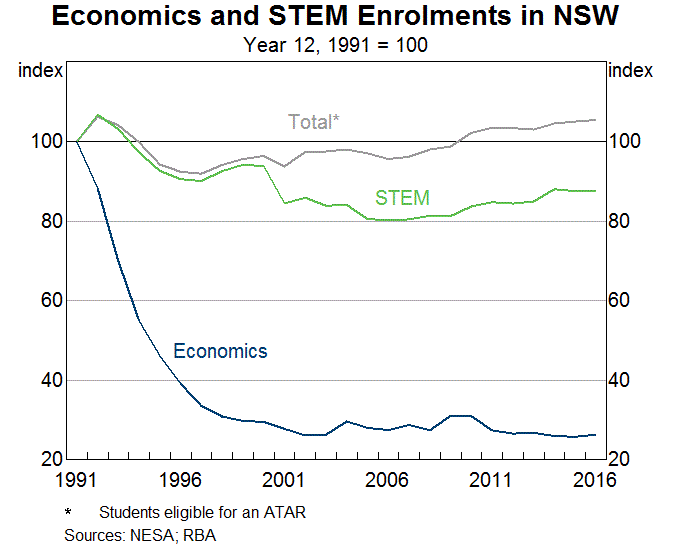
Given the decline in economic enrolments, where is it taught? In the early 1990s, most high schools taught economics. Indeed, over 90 per cent of New South Wales high schools – in both the government and non-government sectors – taught the subject (Graph 5). By 2016, only around 30 per cent of government high schools taught economics, while around 55 per cent of non-government schools taught it.
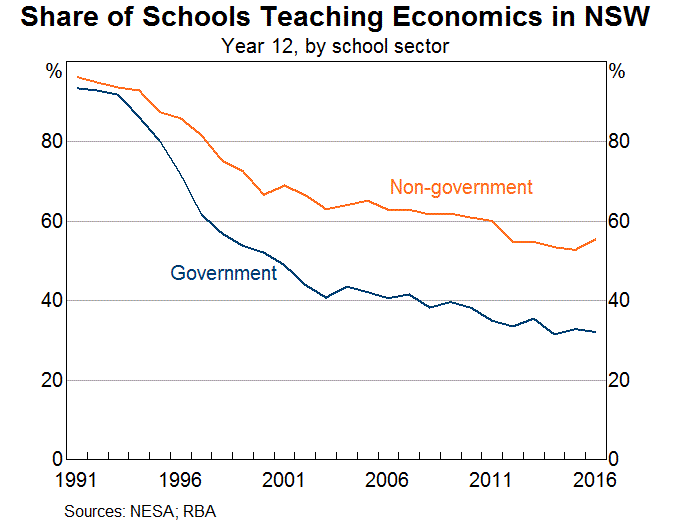
Looking more closely at the types of government schools teaching economics, the fall in the subject offering is a feature of the comprehensive public high schools that most students attend (Graph 6). In contrast, having declined in the early 1990s, the level of economics enrolments in the state's selective schools has remained fairly steady, consistent with economics being an analytical subject (that ‘scales well’ for university admission).
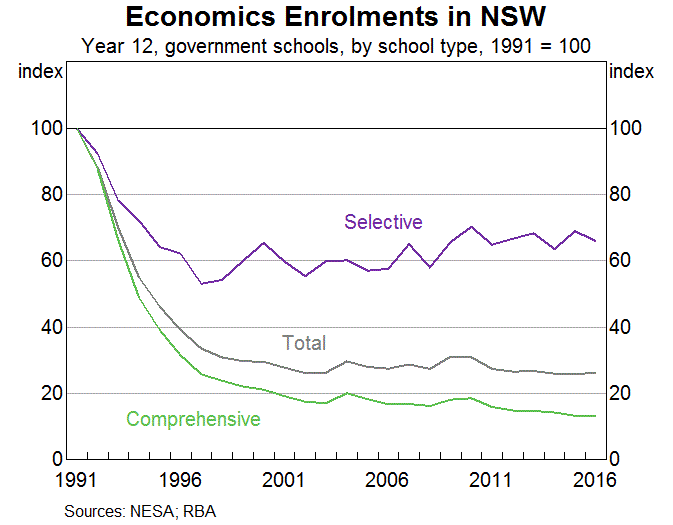
We can look at the different sorts of schools teaching economics another way – by their socio-economic status (SES). We examine enrolments in economics in each high school in New South Wales according to its SES rank. We find that relative to their level in 1991, enrolments have fallen most in those schools with low SES ranks (Graph 7).
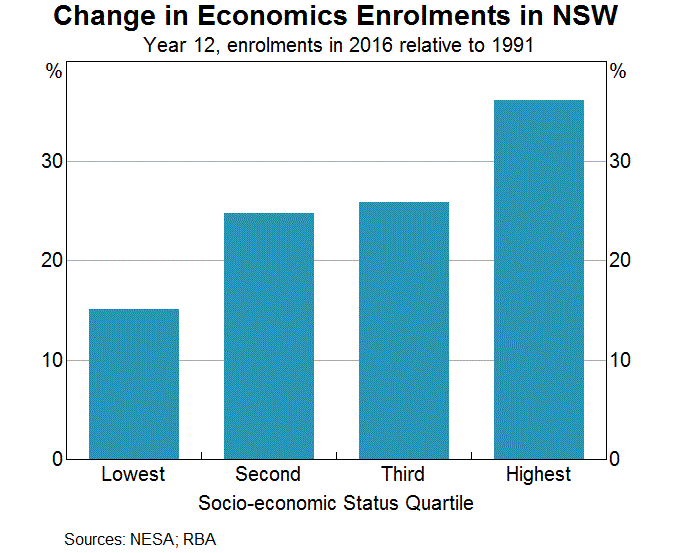
Let's look now at gender, an important dimension of diversity. In the early 1990s, the share of male and female students in an economics class in New South Wales was fairly evenly matched (Graph 8). These days, there are roughly twice as many male students as female students. Importantly, this gender imbalance is much more pronounced than in STEM subjects and runs at odds with the experience of business studies, where the proportion of male and female students has remained reasonably well balanced for many years.
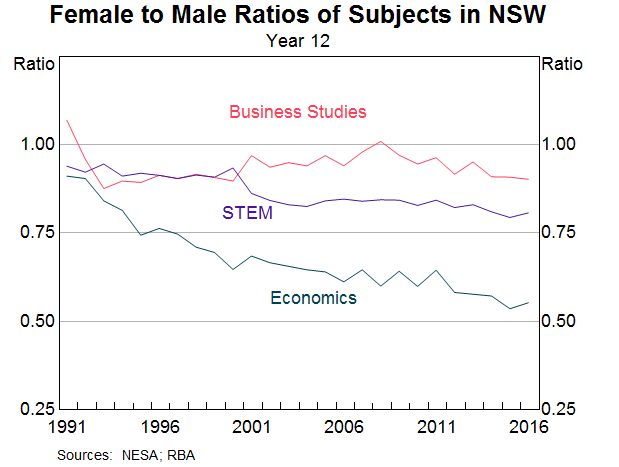
To get a deeper insight into the fall in female participation in economics at high school, we can distinguish between enrolments in co-educational and single-sex schools in New South Wales. As shown in Graph 9, the fall in female participation has been most pronounced in the comprehensive, co-educational government schools. (Where schools are single-sex or selective, female enrolments in economics have not declined as dramatically.)
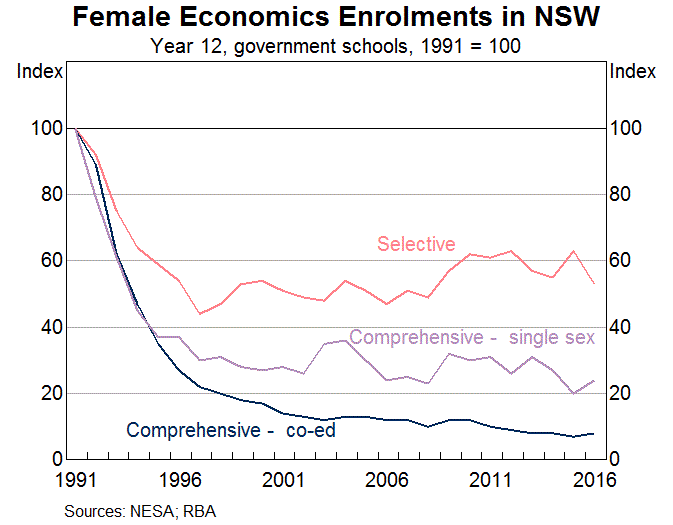
Taken together, the enrolments data in our New South Wales case study paint a picture of an economics student population that is falling in size and diversity.
The Bank's Response
Addressing the diminishing size and diversity of the economics student population is important for the longer-term health of the economics profession – not just the pool of economists from which organisations can recruit. The Bank has recognised the importance of supporting economics educators and students, at both the high school and tertiary level. We have established a small team to coordinate our efforts and I can highlight some of the key initiatives.
The Bank has invited a group of external education experts to form an Educators Advisory Panel to provide feedback and guidance on our initiatives in support of economics. (The Panel comprises presidents of the national and state associations for economics educators, a careers advisory body, two academics and two ‘best practice’ teachers.)
Efforts are being made to ensure that additional content is made available on the Bank's website that is directly relevant to the needs of educators and students.
Professional development activities for economics educators are being planned for accreditation, and a Teacher Immersion event has already been held, with attendance by high school economics teachers from across the country.
An Ambassador program has also been established, with a group of Bank economists being equipped to deliver talks to teachers and students on aspects of Bank work that are relevant to their syllabus.
These Ambassadors not only explain economic content. They are advocates for economics and exemplify in the classroom what economics is and what an economist can be. And half of them are female. Their activities are complemented by the Bank's sponsorship of a Premiers' Teaching Scholarship devoted to developing a more inclusive approach to teaching economics to women and girls.[4]
Economics Matters
The analytic skills and frameworks acquired in the study of economics can be used to explain or debate much of the world in which we live – from understanding the opportunity cost entailed in the many personal decisions we make, through to the big questions about why various groups in society experience such different outcomes in their economic wellbeing. As such, an understanding of economics can inform a range of choices, including political ones. It is widely opined that the quality of public discourse in Australia – and elsewhere – has fallen and would benefit from greater economic literacy and engagement with economics ideas. In fact, as the biographer Tim Rowse explains, Dr Coombs was highly attuned to the importance of economists in contributing to ‘… a critical discourse about public policy based on knowledge of ‘‘the economy’’’.[5]
Your students have a vital interest in what makes good public policy. As young people, they want to know what the future holds for them. Whereas many professionals tend to focus on Bank communication in terms of signals about the near-term outlook for interest rates, students look for answers to bigger questions. They consistently ask Bank presenters about issues of long-term economic growth, intergenerational equity, job opportunity, income distribution, how they can ever afford property, how economies can avoid another financial crisis, and how economic incentives can be used to protect the environment. The questions they ask go to broader issues of economic and social wellbeing.
In closing, Coombs thought that to ‘… be an economist was to present conscientiously to the public answers to the question: how to revalue the resources we have so as to use them sustainably and equitably?’.[6] As these are the very things asked each day by your students, perhaps in our attempts to re-engage the student population with economics, there remains much to be learned from Dr HC Coombs.
Endnotes
This speech incorporates research by Tanya Livermore, the Bank's Public Education Economist, and Tim Atkin, while on secondment to the Public Access & Education Section. It has also benefited from research by Sarah Middleton-Jones from the Bank's Archives and comments from Alex Heath, Head of Economic Analysis. My thanks to all Bank staff involved. I would also like to thank the State boards of study for their provision of high school enrolments data. [*]
His first appointments were at schools in Pingelly and Katanning, Western Australia. [1]
As evident in the transcripts of Boris Schedvin's interview with Coombs for the Reserve Bank's official history project on 12 June 1986, Reserve Bank of Australia Archives, file SD92-00873. [2]
We would like to thank the New South Wales Education Standards Authority (NESA) for providing us with detailed enrolments data. [3]
This is currently organised by the Bank's Human Resources Department as part of a wider program of work on diversity and inclusion. [4]
Rowse, T. (2002), Nugget Coombs: A Reforming Life, Cambridge University Press, p 4. [5]
Rowse, T. (2002), Nugget Coombs: A Reforming Life, Cambridge University Press, p 5. [6]